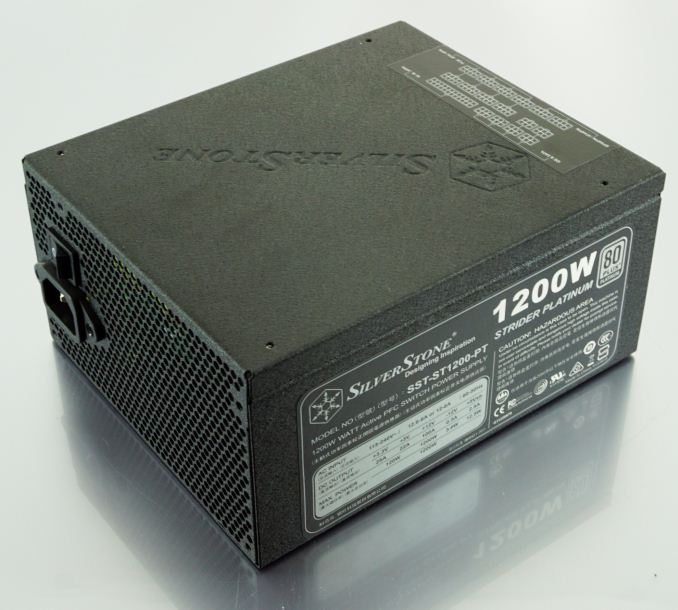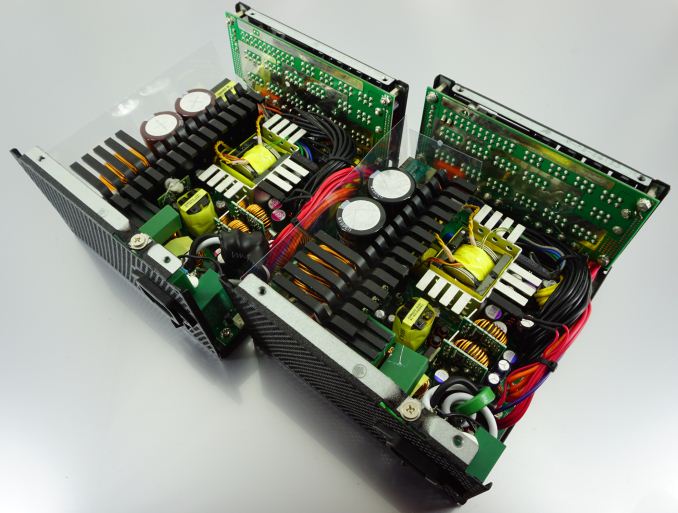The SilverStone Strider Platinum ST1000-PT & ST1200-PT PSU Review: Tenured
by E. Fylladitakis on May 4, 2018 9:00 AM EST- Posted in
- Cases/Cooling/PSUs
- PSUs
- SilverStone
- 80Plus Platinum
Conclusion
Summing up our thoughts, let's start with a look at what separates the Strider Platinum ST1000-PT and ST1200-PT from each other; or rather in this case, the lack of separation. Due to their practically identical target markets – high-end gamers and professionals who intent on using more than two GPUs – the two PSUs are all but indistinguishable, both physically and in terms of performance. The only practical difference between the two units is that the ST1000-PT has six PCIe connectors, whereas the ST1200-PT sports eight, allowing the connection of an additional graphics card. Other than that, the appearance, quality, and even performance of the two PSUs is practically identical. The ST1200-PT displayed a tiny performance advantage in our review but this advantage was very small and, considering that the ST1000-PT was struggling to reach the 80Plus Platinum certification limits, it could have been just a manufacturing tolerance error between the two units.
The Strider Platinum 1000W and 1200W PSUs are very well made, with exceptional quality components. On the outside, SilverStone kept their aesthetics simple and elegant, with the engraved company logo at the top of the PSUs and the unique textured paint. Both units feature a full set of modular flat black cables, including the ATX 24-pin cable, that are preferred over sleeved cables when aesthetics are important. Inside the units we found SilverStone's "penetrator" cooling fans and a proven Enhance platform. Enhance did an excellent job keeping the design clean, the components of high quality, and the assembly job seamless.
Enhance's approach to high-end PSUs is different than that of most manufacturers. They focus almost the entirety of their energy on making the PSU reliable and relatively simple. We first saw the platform used in the ST1000-PT and the ST1200-PT almost a decade ago, meaning that as it's now an older design, Enhance has opted to boost the efficiency of the design primarily by using higher quality active components and relatively small additions/upgrades rather than trying new techniques. This is not necessarily a bad thing, as the manufacturer has accumulated a lot of experience on this particular platform, ensuring better quality control and proven long-term reliability.
On the other hand, by sticking to "what works", Enhance is not really trying to compete with the other OEMs in terms of performance. Everything regarding the performance of Strider Platinum units is acceptable but, on the other hand, the two high-end units do not actually excel anywhere. Both units barely reach their efficiency ratings and the electrical power quality is satisfactory but unexceptional, especially considering their class. The thermal performance is very good but the cooling profile is unbalanced, forcing the fans to overtask even when the temperature of the units is low. The fans do stop when the system is idling but will instantly reach audible levels with just a mediocre load.
The two most powerful SilverStone Strider Platinum units undoubtedly are very well made and reliable, as well as relatively compact for their power output, but their competitiveness in today's market is mediocre. Overall, the performance of both the ST1000-PT and the ST1200-PT is good, yet unimpressive, reducing the competitiveness of the two units against other products that are similarly priced and offer significantly better electrical and/or thermal performance. As only gamers and professionals who use three or more GPUs are virtually the only market of >=1kW units, it is a relatively small (and demanding) percentage of the market, in which the Strider Platinum does not display any other distinct advantage over the competition other than its proven quality. The high stability of the SilverStone Strider Platinum units under maximum load makes them very good for applications where the units will be heavily loaded 24/7, which may make them appealing to cryptominers during sale seasons and when offers are active.












21 Comments
View All Comments
Samus - Saturday, May 5, 2018 - link
I'm still rocking an 11 year old PCP&C 750 Quad. 80 Plus something or other rating. I think it was rated 80 Plus before there were even sub-categories of 80 Plus.notashill - Tuesday, May 8, 2018 - link
I had the same PSU but it died (for the second time, first was under warranty and it was repaired not replaced) about a year and a half ago. Still not a bad service life.DanNeely - Tuesday, May 8, 2018 - link
That was a very good supply in its day, and is probably fine to keep using in whatever you've got it in for as long as you keep it. I'd be hesitant to install it in a new built system today though.I can't find any reviews that did a cross load test on it; but from its age it's almost certainly a design with separate 12V and 3.3/5V segments whose voltages get out of spec if you put a huge load one of them and barely anything on the second (aka cross load).
That's an issue because modern systems use 12V almost exclusively and put very little load on the 3.3/5V rail (PCIe cards can draw up to 10W@3.3V, a few years ago AMD was to get the most power out of the slot, nvidia was limiting itself to the 65W available at 12V; USB draws 5V for most uses, 2.5/3.5" drives might tap 5V, but almost never touch the 3.3V line because of molex to sata adapters that leave it unpowered); which puts older PSUs into a cross load situation if you're running GPUs and load the 12V rail heavily. Newer designs avoided this by going pure 12V at the AC-DC conversion step and then making lower voltages via DC-DC conversion.
Achaios - Friday, May 4, 2018 - link
"considering that the ST1000-PT was struggling to reach the 80Plus Platinum certification limits"@E.F: You should know, since you are a PSU specialist, that Silverstone has got a history of marketing units made by Enhance, which fail to meet the Certification limits or barely make it.
Case in point, my own Silverstone Strider Gold 850W. This unit fails to meet the Gold Certification by 1-2 %. This is a year 2011 PSU and the reviewer who first noted the fact was Johnny Guru.
After, what, 7 years Silverstone learned nothing from the negative publicity and they just keep doing the same thing. Ofc such data does not concern the average buyer out there who buy PSU's b/c of attractive packaging or good price, just us enthusiasts.
Silverstone sells good, solid units, just not without flaws and not the best-of-the-best. I'd label them Tier 2 or Tier 3.
stanleyipkiss - Friday, May 4, 2018 - link
Who is Tier 1 then?praeses - Friday, May 4, 2018 - link
Seasonicpraeses - Friday, May 4, 2018 - link
... and probably FSP Group after them.Fallen Kell - Friday, May 4, 2018 - link
Tier 1 is Seasonic, FSP, Corsair, and Enermax who design (and in the case of Enermax build) their own power supplies. Many of the other ones simply use an OEM design, possibly with a few modifications, but in many cases it is simply an OEM with specific paint/color scheme, or specific cables, etc..praeses - Friday, May 4, 2018 - link
Corsair is usually Seasonic or FSP. I'm not sure that I would put Enermax in the same tier as Seasonic/FSP.piroroadkill - Monday, May 7, 2018 - link
As far as I recall, Corsair uses Great Wall for a good number of their mid-range units, and Flextronics at the very high end.